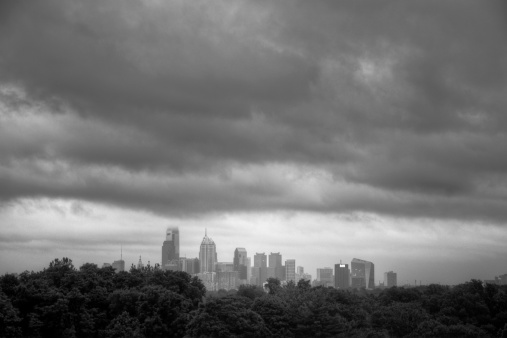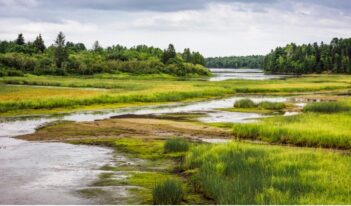
Projects will support urban stormwater management, with a focus on Philadelphia.
Philadelphia is the first U.S. city to attempt an ambitious goal: a large-scale green infrastructure plan to manage its stormwater. By expanding green infrastructure—that is, such things as gardens, green roofs, and rain barrels—Philadelphia is seeking to capture or divert rainwater and keep it from overflowing the city’s sewer system in heavy storms. In support of the city’s efforts, the Environmental Protection Agency (EPA) recently announced that it will award about five million dollars in grants to the University of Pennsylvania, Temple University, Swarthmore College, and Villanova University to spend several years studying green infrastructure.
In 2012, Philadelphia was the first city to receive approval from the EPA for a water pollution control plan based almost exclusively on green infrastructure. That same year, the EPA and Philadelphia also signed a partnership agreement, in which the EPA agreed to support the city’s implementation of its plan. The recent grants to Philadelphia-area colleges are an outgrowth of the EPA’s commitment.
Green infrastructure appears to be more cost-effective and environmentally sound than gray infrastructure, which diverts stormwater runoff directly into storm drains, sewer systems, or storage tunnels. Other U.S. cities are interested in using green infrastructure to comply with EPA’s stormwater runoff regulations. According to The Regulatory Review’s interview with Professor David Hsu, co-leader of the University of Pennsylvania grant project, the EPA is awarding these grants to ensure that water pollution control plans based on green infrastructure are successful in both Philadelphia and in other U.S. cities. But ensuring their success, Hsu explains, is not an easy task.
Philadelphia is one of hundreds of U.S. communities that have a combined sewer system, which processes both stormwater and sewage. During heavy rains, excess stormwater enters the system, resulting in the discharge of stormwater and untreated sewage into waterways. Impervious surfaces, such as concrete parking lots, exacerbate the problem because stormwater cannot seep into the ground and instead flows directly into the sewer system. Traditionally, cities have dealt with combined sewage overflow using storage tunnels, which hold excess stormwater during a storm. Yet these tunnels can cost billions of dollars in large cities like Philadelphia.
In its green infrastructure plan, entitled Green City, Clean Waters, Philadelphia has opted to implement green infrastructure, such as pervious pavement, green roofs, and rain barrels, which would allow stormwater to seep into the ground instead of flowing immediately into the sewer system. The plan will likely cost about two billion dollars to implement over the next twenty years, but it aims to reduce stormwater runoff into the sewer system by over eighty percent.
To comply with both state and federal stormwater runoff policies, the plan strives to use green infrastructure to create “greened acres” in one-third of the city, or about 550 acres per year. Greened acres filter or store the first inch of stormwater for an hour prior to it flowing into the sewer system. According to Hsu, the city’s ambitious plan faces several financial barriers.
Currently, the Philadelphia Water Department, which regulates stormwater in the city, charges commercial and residential property owners higher stormwater fees based on the amount of impervious surface relative to their property area, as opposed to the amount of water they use. In doing so, the city hopes to encourage commercial property owners to implement green infrastructure and reduce their stormwater fees. (Residential property owners are not yet eligible for such fee deductions).
But, according to Hsu, the increased stormwater fee is too low to encourage private investment in green infrastructure. Additionally, Hsu explains that there are other financial barriers to widespread adoption of green infrastructure, including: lack of information, such as the future schedule of stormwater charges; high transaction costs, which constitute twenty to forty percent of green infrastructure costs; and very long-term maintenance agreements that have uncertain costs.
Hsu and his team at the University of Pennsylvania plan to use their EPA grant to develop financial incentives and information tools to stimulate private investment in green infrastructure. For instance, Hsu suggests that information exchange can lower initial transaction costs and that standardized maintenance legal agreements can reduce legal fees.
Temple University researchers plan to use the university campus as a test site to study several facets of practical implementation of green infrastructure, including related socio-economic issues. Villanova University researchers will focus on the engineering of green infrastructure to develop next-generation devices. Swarthmore College researchers plan to conduct cost-benefit analyses for various in-the-ground green infrastructure.
According to the Philadelphia Water Department’s Public Affairs Director, Joanne Dahme, “The grants will fund and coordinate research that will help advance Green City, Clean Waters implementation, but it will also help ensure that other cities around the country learn from what we’re doing here.” Additionally, Villanova researchers explain that because the projects collectively support Philadelphia in the first “distributed approach to stormwater management . . . on a city-wide scale,” the projects also “have the potential to change stormwater management internationally.”
It is unclear how the EPA-funded projects will affect Philadelphia’s stormwater regulations in the future. The regulations require developers doing construction or re-development on properties roughly 15,000 square feet or greater to submit stormwater management plans. The plans must use green infrastructure to create a greened acre on the property and developers cannot receive zoning or building permits until the city approves their plans.
Hsu believes that these stormwater regulations will soon affect smaller residential properties as an essential step to achieving 550 greened acres in Philadelphia annually. Yet, as Dahme points out in an interview with The Regulatory Review, individual residents do not have the space to create a greened acre on their properties. Still, Dahme states that Philadelphia is “looking at a number of pay for performance models in which properties can be bundled—public and private—to leverage stormwater capture and reduce overall green acre costs.”
In addition to the grants awarded to the Philadelphia-area schools, the EPA also awarded a grant to the University of New Hampshire, where researchers will develop tools to improve the local implementation of green infrastructure, taking into account relevant social, economic, and environmental factors.



